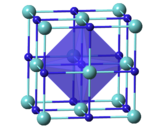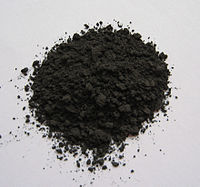Zirconium carbide
 |
|
 |
|
| Names | |
|---|---|
| Other names
Zirconium(I) carbide
|
|
| Identifiers | |
| ECHA InfoCard | 100.031.920 |
| UN number | 3178 |
| Properties | |
| CZr | |
| Molar mass | 103.24 g·mol−1 |
| Appearance | Gray refractory solid |
| Odor | Odorless |
| Density | 6.73 g/cm3 (24 °C) |
| Melting point | 3,532–3,540 °C (6,390–6,404 °F; 3,805–3,813 K) |
| Boiling point | 5,100 °C (9,210 °F; 5,370 K) |
| Insoluble | |
| Solubility | Soluble in concentrated H2SO4, HF,HNO3 |
| Structure | |
| Cubic, cF8 | |
| Fm3m, No. 225 | |
|
a = 4.6976(4) Å
α = 90°, β = 90°, γ = 90°
|
|
| Octahedral | |
| Thermochemistry | |
| 37.442 J/mol·K | |
|
Std molar
entropy (S |
33.14 J/mol·K |
|
Std enthalpy of
formation (ΔfH |
−207 kJ/mol (extrapolated to stoichiometric composition) −196.65 kJ/mol |
| Hazards | |
| Main hazards | Pyrophoric |
| GHS pictograms |
 
|
| GHS signal word | Danger |
| H228, H302, H312, H332 | |
| P210, P280 | |
| NFPA 704 | |
| Related compounds | |
|
Other anions
|
Zirconium nitride Zirconium oxide |
|
Other cations
|
Titanium carbide Hafnium carbide Vanadium carbide Niobium carbide Tantalum carbide Chromium carbide Molybdenum carbide Tungsten carbide |
|
Except where otherwise noted, data are given for materials in their standard state (at 25 °C [77 °F], 100 kPa).
|
|
|
|
|
| Infobox references | |
Zirconium carbide (ZrC) is an extremely hard refractory ceramic material, commercially used in tool bits for cutting tools. It is usually processed by sintering.
It has the appearance of a gray metallic powder with cubic crystal structure. It is highly corrosion resistant. This Group IV interstitial transition-metal carbide is also a member of ultra high temperature ceramics or (UHTC). Due to the presence of metallic bonding, ZrC has a thermal conductivity of 20.5 W/m·K and an electrical conductivity (resistivity ~43 μΩ·cm), both of which are similar to that for zirconium metal. The strong covalent Zr-C bond gives this material a very high melting point (~3530 °C), high modulus (~440 GPa) and hardness (25 GPa). ZrC has a lower density (6.73 g/cm3) compared to other carbides like WC (15.8 g/cm3), TaC (14.5 g/cm3) or HfC (12.67 g/cm3). ZrC seems suitable for use in re-entry vehicles, rocket/SCRAM jet engines or supersonic vehicles in which low densities and high temperatures load-bearing capabilities are crucial requirements.
Like most carbides of refractory metals, zirconium carbide is sub-stoichiometric, i.e., it contains carbon vacancies. At carbon contents higher than approximately ZrC0.98 the material contains free carbon. ZrC is stable for a carbon-to-metal ratio ranging from 0.65 to 0.98.
...
Wikipedia

